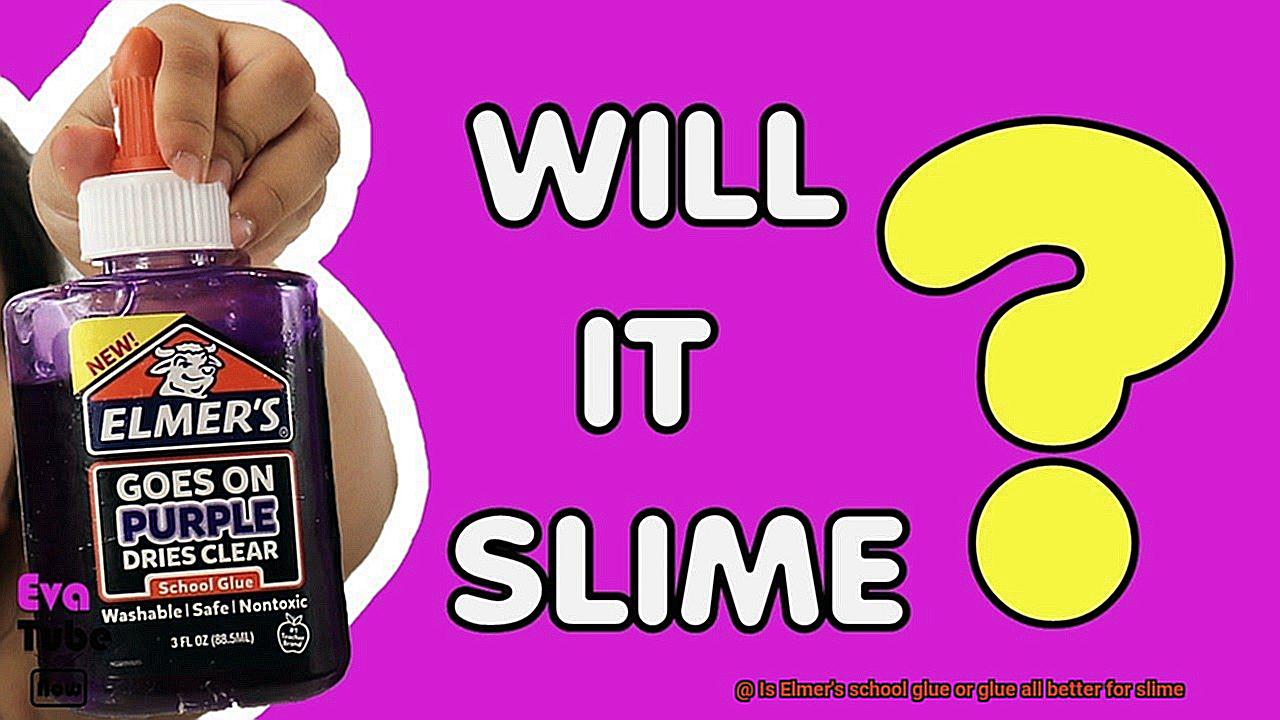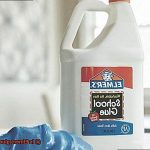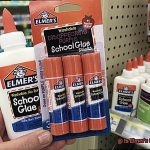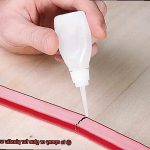Hey there, fellow slime lovers. Are you tired of spending countless hours on YouTube trying to figure out which glue is better for making the perfect slime? Look no further, because we’ve got you covered.
The age-old debate between Elmer’s School Glue and Glue-All has been going on for years. But fear not, we’re here to settle it once and for all.
In this post, we’ll be diving deep into the characteristics that set these two glues apart. From their adhesive properties to their texture and ease of use, we’ll analyze every aspect of both Elmer’s School Glue and Glue-All. And of course, what better way to put them to the test than by making some slime?
Whether you’re a seasoned slime pro or just starting out on your gooey journey, this post is for you. So sit back, relax, and get ready to learn everything you need to know about Elmer’s School Glue vs Glue-All when it comes to making the ultimate slime concoction.
What is Slime?
Contents
Slime has taken the toy world by storm, captivating children with its stretchy, gooey texture that behaves like both a liquid and a solid. It’s a non-Newtonian fluid, which means it doesn’t behave like normal liquids. Instead, it can be molded and stretched like a solid, while still flowing like a liquid.
One of the key ingredients in making slime is glue. While there are many types of glue available, Elmer’s school glue and glue all are the most popular choices for slime-making enthusiasts.
Elmer’s school glue is a white, water-based glue that is non-toxic and washable. It’s commonly used in schools for arts and crafts projects because of its affordability and accessibility. For those on a budget or new to slime-making, Elmer’s school glue is an excellent option. However, it can be a bit tricky to work with as it tends to be runny and takes longer to thicken.
On the other hand, glue all is a stronger adhesive that provides a firmer hold and dries clear. Like Elmer’s school glue, it’s also water-based and non-toxic, making it safe for children to use. Glue all is often used for heavy-duty projects like woodworking or home repairs, but it can also be used for making slime. It’s a great option for those who want firmer and more stretchy slime that dries clear.
So, which one is better for making slime? It all depends on personal preference and the desired texture of the slime. If you’re looking for a runnier slime that takes longer to thicken, Elmer’s school glue may be the way to go. However, if you want firmer and more stretchy slime that dries clear, glue all may be the better choice.

Types of Glue for Slime-Making
Two popular types of glue for slime-making are Elmer’s school glue and Elmer’s glue all. Let’s explore the differences between these two options.
Elmer’s School Glue: The Basics
Elmer’s school glue is a white PVA glue that is commonly used in schools for arts and crafts projects. It is a basic and affordable glue that can be found in most stores. This glue is popular among slime-makers because of its smooth texture and ability to create stretchy and fluffy slime.
Texture and Consistency
When using Elmer’s school glue for slime-making, you may notice that it can be runnier and take longer to thicken compared to other types of glue. However, it can create slime with a smooth, glossy texture that is stretchy and fun to play with.
Advantages
One advantage of using Elmer’s school glue is that it is non-toxic, making it safe for children to use. It is also easy to clean up with water, which is a plus for parents and teachers.
Elmer’s Glue All: The Basics
Elmer’s glue all is a more versatile adhesive that can be used for a wider variety of projects. Unlike school glue, it dries clear and has a stronger hold. When it comes to making slime, Elmer’s glue all can produce a more elastic and stretchy slime compared to school glue.
Texture and Consistency
When using Elmer’s glue all for slime-making, you may notice that it creates a more rubbery and bouncy texture compared to school glue. It also dries clear, which makes it great for creating transparent or translucent slime.
Advantages
One advantage of using Elmer’s glue all is its stronger hold and ability to create firmer slime with better stretchiness. However, it can be more difficult to find in stores and is usually more expensive than Elmer’s school glue.
Elmer’s School Glue
Look no further than Elmer’s School Glue. As an expert in the world of slime, I can tell you that this glue is a reliable and versatile option for making all sorts of slime creations.
One of the best things about Elmer’s School Glue is its safety and affordability. Parents can rest easy knowing that it’s non-toxic and washable, making it a safe choice for kids to experiment with. Additionally, it’s widely available at most stores, so you won’t have to break the bank to get your hands on it.
Another benefit of Elmer’s School Glue is its versatility. This white, PVA glue dries clear, making it the perfect option for creating clear or translucent slime. And while some people have reported a slightly rubbery texture when using this glue, you can easily adjust the ratio of glue and activator to get the texture you want.
It’s important to note that Elmer’s School Glue can take longer to mix with other ingredients compared to other types of glue. However, this can be remedied by adding a small amount of warm water to help it mix more easily. Additionally, adding glitter, food coloring, or other fun additives can take your slime creation to the next level.
Advantages and Disadvantages of Elmer’s School Glue
Let’s take a closer look at the advantages and disadvantages of using this type of glue for making slime.
Advantages:
- Availability: Elmer’s School Glue is widely available in stores, making it incredibly convenient to purchase.
- Easy to mix: This versatile glue can be mixed with a variety of other ingredients, such as food coloring, glitter, and borax, allowing for endless possibilities when experimenting with different textures and colors.
- Safe: Parents can rest easy knowing that Elmer’s School Glue is non-toxic, making it safe for children to use without any concerns about harmful chemicals or fumes.
- Dries clear: Once the glue has dried, it leaves no residue on your hands or clothes, providing a beautiful finished product.
Disadvantages:
- Limited stretchiness: Elmer’s School Glue has its limitations when it comes to stretchiness. If you’re aiming for a super stretchy slime that can be pulled and twisted in all sorts of ways, another type of glue may be necessary.
- Longer drying time: Compared to other types of glue, Elmer’s School Glue takes longer to dry. This means you’ll have to wait a bit longer before you can start playing with your slime.
- Not as strong: Elmer’s School Glue may not hold up as well compared to other types of glue, resulting in a less durable slime that may not last as long.
- Difficulty with certain activators: Some activators, like contact solution or baking soda, may not work well with Elmer’s School Glue, which could lead to a failed slime.

Glue-All
Then you’ve likely come across Glue-All, a popular brand of white school glue that has gained a reputation for its strong bond and quick-drying formula. But what sets Glue-All apart from other glues, like Elmer’s school glue?
One key difference is the consistency. Glue-All is thicker than Elmer’s, making it easier to control the texture of slime while also producing a more stretchy and less sticky final product. This thickness also makes it ideal for use in various art and craft projects.
However, some people have reported difficulty finding Glue-All in stores, especially during peak slime-making seasons. And while it may be slightly more expensive than Elmer’s, the benefits of its consistency outweigh the cost for many slime enthusiasts.
Speaking of Elmer’s school glue, it is a convenient and safe option for making slime. However, its longer drying time and compatibility issues with certain activators could lead to a less successful slime-making experience. Plus, it may not provide the same level of stretchiness or durability as Glue-All.
Ultimately, the choice between Glue-All and Elmer’s school glue comes down to personal preference. Some may prefer the thicker consistency and stretchiness of Glue-All, while others may opt for the affordability and availability of Elmer’s. It’s recommended to try both options to see which works best for your needs.
Advantages and Disadvantages of Glue-All
This popular adhesive has both advantages and disadvantages to consider when it comes to slime-making.
Advantages:
- Versatility: Glue-All is not just for slime-making, but can also be used for a wide range of projects, including paper crafts, woodwork, and sealing. This makes it a great investment for those who want a multi-purpose glue that can be used beyond just slime-making.
- Transparency: Glue-All dries clear, making it ideal for creating transparent or translucent slime. This feature is especially appealing for those who want to add glitter or other embellishments to their creations.
- Availability: Glue-All is widely available in most craft stores and online retailers, making it easy to find and purchase.
Disadvantages:
- Stickiness: Glue-All can be quite sticky and difficult to handle when making slime, which can make it challenging to achieve the desired consistency of the slime. This may be frustrating for beginners or those who prefer a less messy option.
- Drying time: Compared to other types of glue, Glue-All takes longer to dry. This means that those who want to enjoy their slime creations right away may have to wait longer for the glue to fully dry before they can play with their slime.
- Price: Glue-All can be more expensive than other types of glue on the market, which may not be ideal for those on a budget.
Comparison between Elmer’s School Glue and Glue-All
While both are popular choices for slime-making, they have some key differences that can impact the quality of your final product.
Let’s start with Elmer’s School Glue. This classic white glue is a go-to for children’s crafts, thanks to its non-toxic and washable formula. It’s also affordable and easy to find in most stores. When using it for slime, you’ll get a slightly runnier consistency than with Glue-All. This can be great if you want to mix in other ingredients easily, but it may result in a less stretchy slime that breaks apart more easily.
On the other hand, Glue-All is a more versatile adhesive that can be used for a range of projects beyond slime-making. It also dries clear and is non-toxic, making it safe for kids. However, its stronger hold means that it produces a thicker, more elastic slime that holds its shape better than Elmer’s School Glue. While this consistency can be great for playing with and stretching, it may be harder to mix with other ingredients due to its thicker texture.
When making your decision between these two glues, consider what you want from your slime. If you’re looking for a runnier consistency that’s easy to mix with other ingredients, go with Elmer’s School Glue. If you want a thicker, more elastic slime that holds its shape well, choose Glue-All. Either way, both options are safe and non-toxic for children’s crafts.
Tips for Making Slime with Different Types of Glue
If you’re looking to make the ultimate slime, then you need to start with the right glue. There are many types of glue available in the market, each with its own unique properties that can significantly impact the texture and consistency of your slime. In this article, we’ll be discussing two of the most popular types of glue for making slime: Elmer’s School Glue and Elmer’s Glue-All.
Elmer’s School Glue is a widely used PVA (polyvinyl acetate) glue that is commonly found in classrooms for arts and crafts projects. It is easy to find, relatively inexpensive, non-toxic, and washable, making it safe for kids to use. However, one downside to using Elmer’s School Glue is that it can produce a more runny and stretchy slime, which may not be ideal for everyone.
On the other hand, Elmer’s Glue-All is also a PVA glue, but it has a stronger bond and can create a thicker and more firm slime. It dries clear, which makes it an excellent choice if you want your slime to have a transparent or translucent look. However, Elmer’s Glue-All is slightly more expensive than Elmer’s School Glue and can be more challenging to find in stores.
When it comes to making slime with different types of glue, there are a few tips that you should keep in mind. Firstly, always read the instructions on the bottle of glue before using it to make slime. Some glues may require different ratios of ingredients or may have specific mixing instructions.
Secondly, experiment with different types of glue to find the one that works best for you. Try making slime with both Elmer’s School Glue and Elmer’s Glue-All and see which one produces the texture and consistency that you prefer.
Lastly, don’t be afraid to mix different types of glue together. You can create custom slimes by combining different types of glues and adding in other ingredients like food coloring or glitter.
sqdzFMyql-w” >
Also Read: Will Elmer’s glue dissolve in water?
Conclusion
After much consideration, it’s safe to say that the Elmer’s School Glue versus Glue-All debate for slime-making is no small matter. Each glue has its own set of pros and cons, but at the end of the day, it all comes down to personal preference and desired slime texture.
For those new to the world of slime or working on a budget, Elmer’s School Glue is an excellent option. Not only is it non-toxic and easy to clean up with water, but it also produces a glossy, smooth slime that stretches and bounces with ease. However, keep in mind that it may take longer to thicken and may not provide as much stretchiness or durability as Glue-All.
On the other hand, Glue-All is a more versatile adhesive that can be used for heavy-duty projects like woodworking or home repairs. When used for slime-making purposes, it can produce an elastic and stretchy slime that outperforms Elmer’s School Glue in terms of texture. But bear in mind that finding this type of glue may be a bit more challenging than its counterpart and could be slightly more expensive.
To create your ideal slime concoction, start by selecting the right glue for your needs. Don’t hesitate to experiment with different types of glue until you find one that suits you best. Always follow the instructions on the bottle before using any type of glue for slime-making purposes. And if you’re feeling adventurous, try mixing different types of glue together.
In conclusion, whether you choose Elmer’s School Glue or Glue-All for your next batch of slime depends entirely on what you’re looking for in terms of texture and performance.






